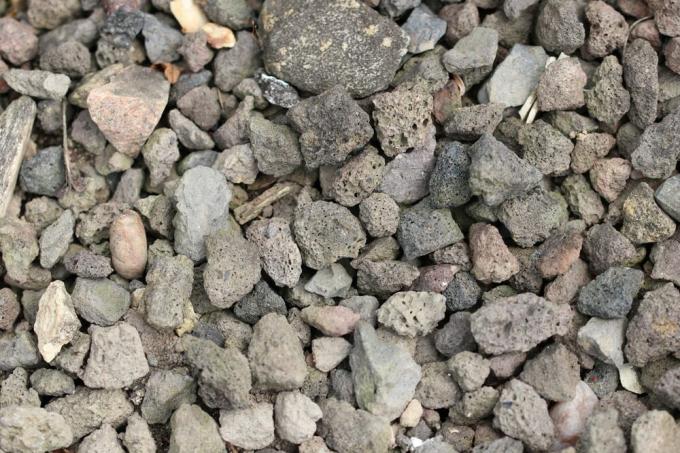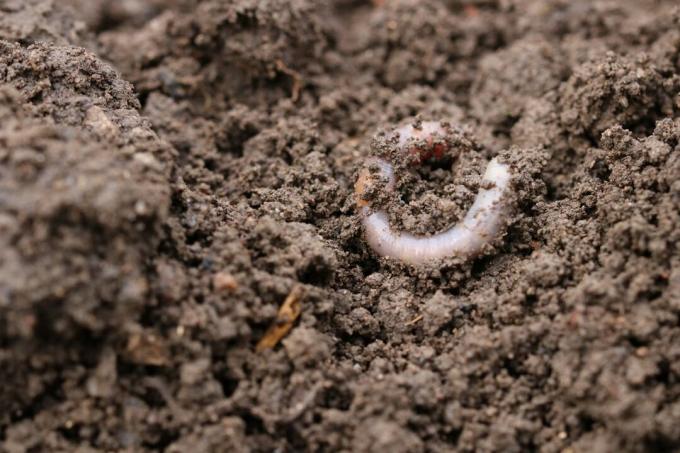

Table of contents
- oxygen
- water-tank
- ground heat
- weed protection
- decoration
- Size
- mixing ratio
- Be careful with root contact
- drainage
- garden pond
Using lava stones in the garden offers a number of advantages, both when planting outdoors and when growing in tubs - if the natural granules are used correctly. The grain size is just as important here as the correct mixture with the substrate. It is also important to know the properties of the lava granules in order to be able to use them in a targeted manner.
oxygen
Lava stones are porous and light. Due to these properties, they loosen the soil and increase the oxygen content. They also ensure improved water drainage, especially in heavy and loamy soils. This reduces the risk of waterlogging.
water-tank
Lava granules store water and slowly release it again. Two advantages arise from this. On the one hand, excess liquid is absorbed from the substrate, which in turn prevents the risk of waterlogging. On the other hand, the stored liquid is released again when the earth becomes drier. In this way, the drying out of the substrate is prevented for longer and the casting effort is reduced. In addition, the soil is stabilized by the continuous moistening and is therefore not easily washed away.
ground heat
Aside from water, lava rocks also store and gradually release heat. As a result, abrupt temperature fluctuations are avoided on the one hand. On the other hand, plants that are sensitive to the cold receive a certain amount of protection from the lava granules. In order to use this property or to use it in a targeted manner, the lava stones can be mixed into the substrate or applied as a layer to the surface.
weed protection
Lava granules also serve as weed control if they are spread about two centimeters thick on the soil. So not only does it reduce soil drying out and retain heat, but it can also prevent the growth of unwanted and competing plants.
decoration

In the trade you will find lava stones not only in different sizes, but also in different colors. This allows different areas in the garden to be delimited or color accents to be set.
Tip:
Colored lava granulate should not be used in the garden pond.
Size
Lava stones are available in different sizes, which means that they can be selected according to their intended use. Recommended are:
- Two to four millimeter large lava granules are suitable for aquariums
- Two to eight millimeters of lava granules are suitable for garden ponds
- Eight to sixteen millimeter large lava stones can be used for mixing with substrate
Any size from 2 to 16 millimeters can be used as a covering mulch on the soil.
mixing ratio
If you want to mix the substrate with lava granules, you should aim for a ratio of 4:1 - i.e. four parts earth and one part lava stones. So that the granules can be distributed evenly in the soil, it is advisable to first mix the soil and stones together in a separate container. The mixing ratio can be varied depending on the condition of the soil and the care requirements of the plant. Plants that require a very loose and well-drained substrate will benefit from a 3:1 ratio. If the soil needs to be a little denser, one part lava granulate can be added to five parts earth. The effort is very small for both mixing and mulching. Since the lava stones do not disintegrate, the measure only has to be carried out once.
Be careful with root contact
As practical as the lava granules are, they should not come into direct contact with roots. There are three reasons for this. On the one hand, although it provides the roots with moisture, it makes it more difficult for them to absorb nutrients. This is solely due to the fact that it increases the distance to the substrate. On the other hand, it increases the oxygen content directly at the roots too much. Many plants are weakened as a result, their growth slows down and their resistance decreases. Another problem is the fine dust that lava stones can give off - if they are not rinsed thoroughly before use. This can also prevent the roots from absorbing nutrients and water from the substrate. The described mixture of soil and granules is therefore better in order to prevent too much contact between the roots and the lava stones. This should be taken into account when repotting potted plants.
drainage

The lava granules used as mulch on the ground are suitable for mixing with the substrate and can also be used as a drainage layer in planters. The largest possible grain size should be used for this. The use is again very simple - the lava stones are only given as a two to four centimeter thick layer on the bottom of the bucket. They store excess water and gradually release it. At the same time, they represent a loose barrier between the substrate and the roots and any standing water in the planter or saucer.
Tip:
If the bucket has very large drainage holes, loose potsherds should first be placed over them and only then should the lava granulate be filled. This prevents the small stones from trickling out of the planter.
garden pond
The lava granules can not only be used in the garden to improve the soil and for the plants, but also serve well in the garden pond. Here it serves as a kind of natural filter medium. Due to its porous nature, it has a very large surface. This allows numerous useful bacteria and microorganisms to settle in the lava stones. These in turn help to break down excess nutrients and harmful substances in the water and thus maintain a healthy balance in the pond. This reduces the risk of the water "tipping over". With this development, too many nutrients accumulate in the water, causing the oxygen content to drop. This worsens the conditions for aquatic plants and aquatic life.
In the garden pond, the lava granules can be used as follows:
- as a medium in the filter
- as substrate
- as a substrate or admixture in the substrate of the aquatic plants used
So that the useful bacteria are not killed off when cleaning the pond, but directly for can ensure good water quality, the stones should only be rinsed off with cool water. Hot water should not be used.
Tip:
Colored lava granules should not be used for the garden pond. The stones should also be rinsed thoroughly and soaked until the water runs clear - before they are placed in the pond.
 garden editorial
garden editorial I write about everything that interests me in my garden.
Learn more about floor care

Digging up the garden: 13 tips for lawns and beds
Whether it makes sense to dig up beds or lawns is discussed in different ways. Once you have decided on this measure, our tips will help you to organize work in the garden effectively.

Pine bark: suitable for which plants?
Pine bark is a type of mulch that is gaining popularity among many garden owners due to its color and properties. Before purchasing, the question often arises as to which plants the bark mulch is suitable for. This question is justified because of the origin of the pine.

Which soil to choose for elephant foot?
The right substrate is crucial for the elephant's foot and should therefore be chosen well. Read here which soil is best suited for the Beaucarnea recurvata!

Expanded clay as a water reservoir: The alternative to earth?
Expanded clay is known to many as a substrate for hydroponics or as drainage in pots. Due to its properties, the clay granulate is suitable as a substrate in many different areas and can replace soil. The granules have long been an indispensable basis for green roofs.

Potting soil: Mix the potting soil yourself
Potting soil has to meet special requirements. It can therefore often make sense to mix potting soil yourself. This comes with several advantages. But what do you have to pay attention to? The guide below shows how to do it.

pH value in the soil: 15 tips for measuring & regulating
If the pH of the garden/plant soil is suboptimal, this can lead to serious plant damage. We show what options there are for measuring and regulating.
